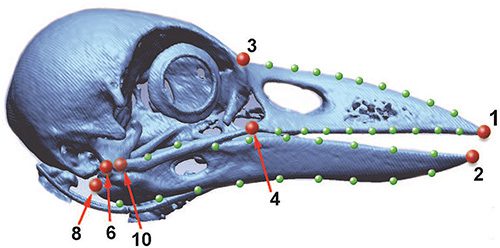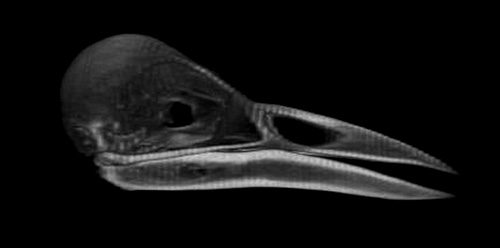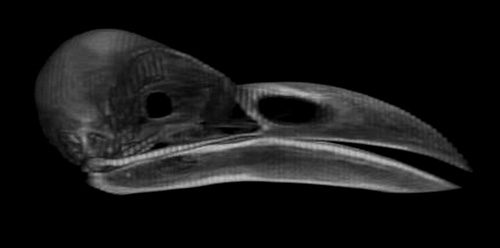Unique Beak Evolved with Tool Use in New Caledonian Crow
By Pat Leonard
March 10, 2016It was as plain as the beak on a bird’s face. Cornell Lab ornithologist and crow expert Kevin McGowan recalls the day in the late 90s when he first saw stuffed specimens of the New Caledonian Crow.








“I remember saying to a student, ‘I don’t know what this bird does, but it does something different from any other corvid on earth because its bill is so weird,’” McGowan says. “And then a couple years later, in 2000, when the paper came out by Gavin Hunt at the University of Auckland, New Zealand, on tool use in these crows, I had the feeling it must be that behavior that made the New Caledonian Crow’s beak so different.”
Now, Hunt, McGowan, and a team of scientists from Japan have quantified what makes the New Caledonian Crow’s beak so different and how it got that way. Their findings have just been published in the journal Scientific Reports.
“We used shape analysis and CT scanning to compare the shape and structure of the New Caledonian Crow’s bill with some of its crow relatives and a woodpecker species with a similar foraging niche,” says lead author Gavin Hunt, a senior research fellow from the University of Auckland’s School of Psychology.
“This study shows that the unique bill contributes to the birds’ ability to use and probably make tools. We argue that the beak became specialized for tool manipulation once the birds began using tools, and that this enhanced tool manipulation ability may have allowed the crows to make more complex tools.”
A tool could be anything from a stick, to a barbed leaf, or a hooked twig used to fish the crow’s favorite food from the trunk of a tree—the juicy grubs of the longhorn beetle. The birds annoy their prey by poking around the grub’s large, sensitive mandibles. When the grub grabs the stick or other tool, the bird hauls it out.


A 3-D reconstruction of the New Caledonian Crow skull with key measuring points. Image courtesy Matsui et al. (2016). 

CT scan of the skull of a New Caledonian Crow. Note the straight and short bill compared to the images below.


The CT scan of a Rook skull reveals a curved bill, but much straighter than most other crows. Rooks are European relatives of American Crows. 

A CT scan of a Large-billed Crow reveals a much more curved and robust bill. Manipulating a small tool would be more difficult with a larger bill.
“Their bill is shorter than a regular crow’s,” McGowan explains. “It’s blunter, and it doesn’t curve down like nearly all bird bills do. The lower mandible actually curves slightly up, which likely gives it the strength it needs to hold the tool. And because the bill doesn’t curve downward it brings the tool into the narrow range of the bird’s binocular vision so it can better see what it is doing.”
Birds with blunter, straighter bills were probably more adept at handling tools for foraging and, over time, nature selected for those bill features. Tool use has now become ingrained in the crow’s biology. In the case of the New Caledonian Crow’s beak, you might say it’s not so much “You are what you eat,” but “You are how you eat.”
“They hold the stick tool so that it goes up along the side of their head along the length of the bill,” McGowan explains. “Apparently there are birds that favor one side of the head over the other–left-sticked or right-sticked, you could call it—it’s really cool!”
Most birds do just fine foraging with their beaks and feet without resorting to using tools, so what made these birds take up tool making? In New Caledonia, the absence of woodpeckers means that there is a rich food source of insects buried in trees that is there for the taking. These crows don’t have the powerful head and bill anatomy of a woodpecker to hammer at trees, but by making tools the birds are able to access this rich food supply. This specialized behavior makes the New Caledonian Crow unique in the bird world.
Reference
Matsui, H. et al. (2016) Adaptive bill morphology for enhanced tool manipulation in New Caledonian crows. Scientific Reports 6, 22776; doi: 10.1038/srep22776.


All About Birds is a free resource
Available for everyone,
funded by donors like you


